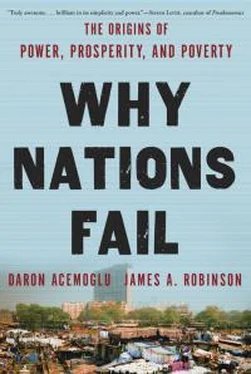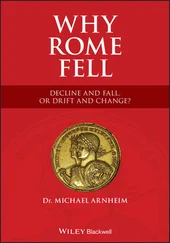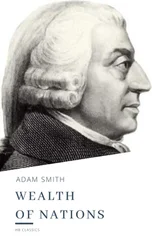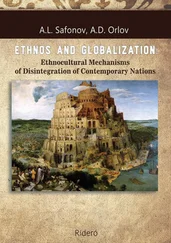The second type of growth under extractive political institutions arises when the institutions permit the development of somewhat, even if not completely, inclusive economic institutions. Many societies with extractive political institutions will shy away from inclusive economic institutions because of fear of creative destruction. But the degree to which the elite manage to monopolize power varies across societies. In some, the position of the elite could be sufficiently secure that they may permit some moves toward inclusive economic institutions when they are fairly certain that this will not threaten their political power. Alternatively, the historical situation could be such as to endow an extractive political regime with rather inclusive economic institutions, which they decide not to block. These provide the second way in which growth can take place under extractive political institutions.
The rapid industrialization of South Korea under General Park is an example. Park came to power via a military coup in 1961, but he did so in a society heavily supported by the United States and with an economy where economic institutions were essentially inclusive. Though Park’s regime was authoritarian, it felt secure enough to promote economic growth, and in fact did so very actively—perhaps partly because the regime was not directly supported by extractive economic institutions. Differently from the Soviet Union and most other cases of growth under extractive institutions, South Korea transitioned from extractive political institutions toward inclusive political institutions in the 1980s. This successful transition was due to a confluence of factors.
By the 1970s, economic institutions in South Korea had become sufficiently inclusive that they reduced one of the strong rationales for extractive political institutions—the economic elite had little to gain from their own or the military’s dominance of politics. The relative equality of income in South Korea also meant that the elite had less to fear from pluralism and democracy. The key influence of the United States, particularly given the threat from North Korea, also meant that the strong democracy movement that challenged the military dictatorship could not be repressed for long. Though General Park’s assassination in 1979 was followed by another military coup, led by Chun Doo-hwan, Chun’s chosen successor, Roh Tae-woo, initiated a process of political reforms that led to the consolidation of a pluralistic democracy after 1992. Of course, no transition of this sort took place in the Soviet Union. In consequence, Soviet growth ran out of steam, and the economy began to collapse in the 1980s and then totally fell apart in the 1990s.
Chinese economic growth today also has several commonalities with both the Soviet and South Korean experiences. While the early stages of Chinese growth were spearheaded by radical market reforms in the agricultural sector, reforms in the industrial sector have been more muted. Even today, the state and the Communist Party play a central role in deciding which sectors and which companies will receive additional capital and will expand—in the process, making and breaking fortunes. As in the Soviet Union in its heyday, China is growing rapidly, but this is still growth under extractive institutions, under the control of the state, with little sign of a transition to inclusive political institutions. The fact that Chinese economic institutions are still far from fully inclusive also suggests that a South Korean–style transition is less likely, though of course not impossible.
It is worth noting that political centralization is key to both ways in which growth under extractive political institutions can occur. Without some degree of political centralization, the planter elite in Barbados, Cuba, Haiti, and Jamaica would not have been able to keep law and order and defend their own assets and property. Without significant political centralization and a firm grip on political power, neither the South Korean military elites nor the Chinese Communist Party would have felt secure enough to manufacture significant economic reforms and still manage to cling to power. And without such centralization, the state in the Soviet Union or China could not have been able to coordinate economic activity to channel resources toward high productivity areas. A major dividing line between extractive political institutions is therefore their degree of political centralization. Those without it, such as many in sub-Saharan Africa, will find it difficult to achieve even limited growth.
Even though extractive institutions can generate some growth, they will usually not generate sustained economic growth, and certainly not the type of growth that is accompanied by creative destruction. When both political and economic institutions are extractive, the incentives will not be there for creative destruction and technological change. For a while the state may be able to create rapid economic growth by allocating resources and people by fiat, but this process is intrinsically limited. When the limits are hit, growth stops, as it did in the Soviet Union in the 1970s. Even when the Soviets achieved rapid economic growth, there was little technological change in most of the economy, though by pouring massive resources into the military they were able to develop military technologies and even pull ahead of the United States in the space and nuclear race for a short while. But this growth without creative destruction and without broad-based technological innovation was not sustainable and came to an abrupt end.
In addition, the arrangements that support economic growth under extractive political institutions are, by their nature, fragile—they can collapse or can be easily destroyed by the infighting that the extractive institutions themselves generate. In fact, extractive political and economic institutions create a general tendency for infighting, because they lead to the concentration of wealth and power in the hands of a narrow elite. If another group can overwhelm and outmaneuver this elite and take control of the state, they will be the ones enjoying this wealth and power. Consequently, as our discussion of the collapse of the later Roman Empire and the Maya cities will illustrate (this page and this page), fighting to control the all-powerful state is always latent, and it will periodically intensify and bring the undoing of these regimes, as it turns into civil war and sometimes into total breakdown and collapse of the state. One implication of this is that even if a society under extractive institutions initially achieves some degree of state centralization, it will not last. In fact, the infighting to take control of extractive institutions often leads to civil wars and widespread lawlessness, enshrining a persistent absence of state centralization as in many nations in sub-Saharan Africa and some in Latin America and South Asia.
Finally, when growth comes under extractive political institutions but where economic institutions have inclusive aspects, as they did in South Korea, there is always the danger that economic institutions become more extractive and growth stops. Those controlling political power will eventually find it more beneficial to use their power to limit competition, to increase their share of the pie, or even to steal and loot from others rather than support economic progress. The distribution and ability to exercise power will ultimately undermine the very foundations of economic prosperity, unless political institutions are transformed from extractive to inclusive.
4.
SMALL DIFFERENCES AND CRITICAL JUNCTURES: THE WEIGHT OF HISTORY
THE WORLD THE PLAGUE CREATED
IN 1346 THE BUBONIC plague, the Black Death, reached the port city of Tana at the mouth of the River Don on the Black Sea. Transmitted by fleas living on rats, the plague was brought from China by traders traveling along the Silk Road, the great trans-Asian commercial artery. Thanks to Genoese traders, the rats were soon spreading the fleas and the plague from Tana to the entire Mediterranean. By early 1347, the plague had reached Constantinople. In the spring of 1348, it was spreading through France and North Africa and up the boot of Italy. The plague wiped out about half of the population of any area it hit. Its arrival in the Italian city of Florence was witnessed firsthand by the Italian writer Giovanni Boccaccio. He later recalled:
Читать дальше












